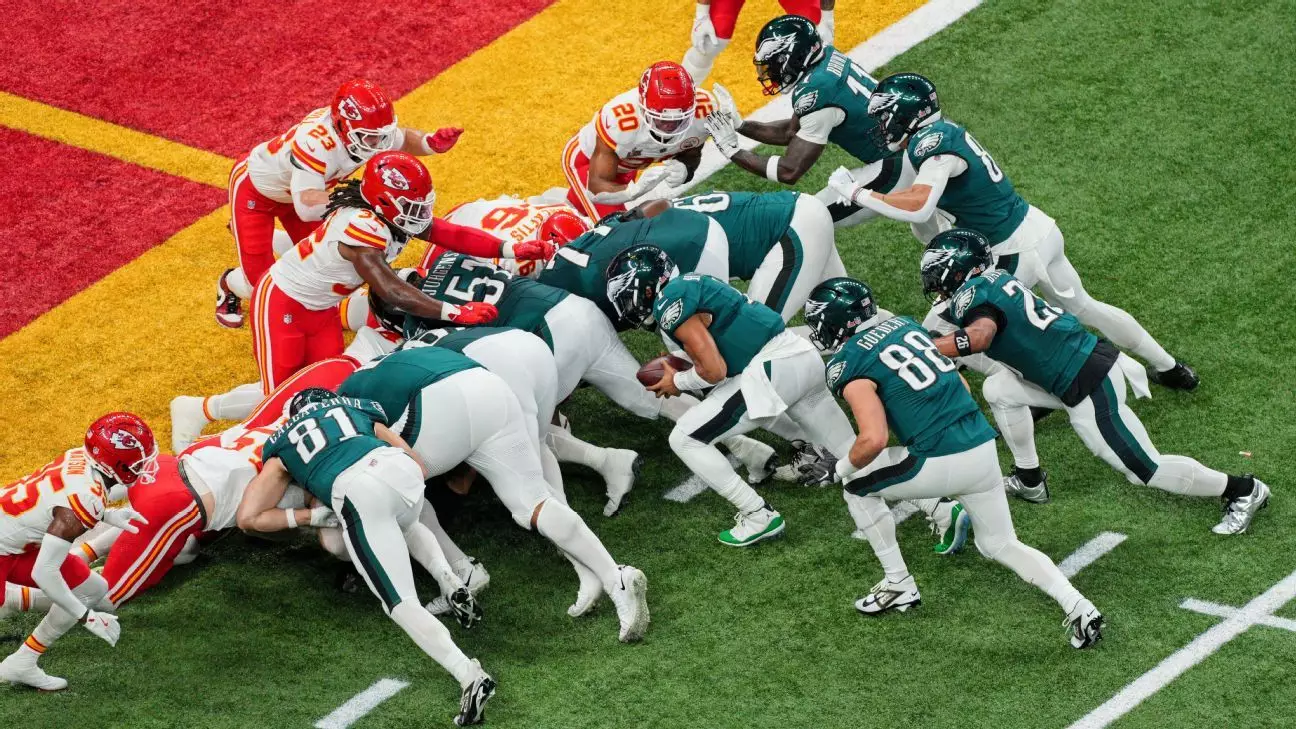In a surprising turn of events at the NFL scouting combine, a team has proposed a notable rule change aimed at banning the so-called “tush push” quarterback sneak, a technique made famous by the Philadelphia Eagles and the Buffalo Bills. This advanced play has generated significant discussion within league circles, and its potential ban could have wide-ranging implications for how offensive strategies are developed in professional football. While the identity of the team that submitted the proposal remains under wraps, it reflects a growing concern about the efficacy and safety of this controversial maneuver.
The Mechanics of the Tush Push
The “tush push” involves a quarterback, typically lined up behind the center, taking the snap while being assisted by a designated player or players who push him forward, effectively surging against the opposing defense. This play has been executed with remarkable success by the Eagles and Bills, with a striking 163 successful attempts in just three seasons. The Eagles’ adaptation of the play, dubbed the “Brotherly Shove,” notably showcased its effectiveness during critical moments, including scoring opportunities in high-stakes games like the Super Bowl.
Statistics reveal that these two teams achieved approximately 87% success in converting this play for either touchdowns or first downs. In stark contrast, the rest of the league saw only a 71% success rate with similar attempts. The stark disparity in effectiveness raises questions about the fairness of the play, sparking debates around its potential ban.
Troy Vincent, the NFL’s executive vice president of football operations, acknowledged the ongoing deliberation around this rule proposal during a break in the scouting combine meetings. He emphasized the need for a thoughtful examination of whether the “tush push” constitutes a viable football play or if adjustments are necessary to create a level playing field. This suggestion to reconsider the play isn’t new—it has been a point of contention discussed during previous offseasons without any definitive action taken.
Moreover, there have been observed challenges associated with the play. For instance, referees have had to deal with infractions such as offsides penalties aimed at countering the push. The notable instance with Washington Commanders linebacker Frankie Luvu illustrates the tactical challenges teams face in defending against this maneuver. If the “tush push” continues to dominate play strategy, additional defensive tactics may need to evolve, leading to a potential arms race, which the league may wish to avoid.
The proposal to eliminate or significantly modify the “tush push” comes as teams weigh their strategic options. Philadelphia Eagles head coach Nick Sirianni has voiced his opposition to any potential changes, citing the unique success that his team has achieved through this play. This brings up an important discussion point: Should a successful tactic be banned simply because it is less effective for other teams?
As teams submit rule proposals annually, the question at hand remains whether this move is a reaction to the dominance of certain teams or part of a broader concern about player safety and competitive balance. Prior to this latest proposal, discussions had already yielded limited action, with the NFL focusing on other tackling techniques rather than this offensive strategy.
With the upcoming spring owners’ meeting set for next month in Palm Beach, Florida, the fate of the “tush push” will soon be in the hands of the NFL’s franchise owners. Should the proposal be presented for a vote, it requires a two-thirds majority—specifically, 24 out of 32 votes—to pass. The outcome could shape not just how the Eagles or Bills strategize moving forward, but also influence the overall landscape of offensive gameplay in the NFL.
As this debate unfolds, it encapsulates the delicate balance the league must maintain between innovation and tradition, safety and competitiveness. Whether the rule proposal will pass remains uncertain, but it certainly captures the essence of how evolving strategies continue to challenge the foundations of football as a sport. The league’s willingness to adapt will ultimately dictate how teams and fans alike will engage with this now-iconic play in the seasons to come.

